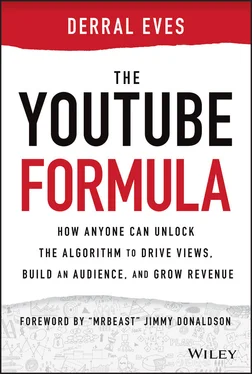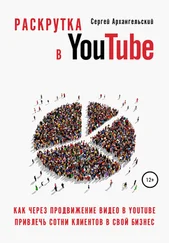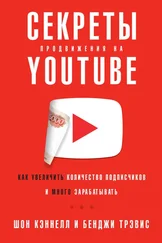Uniting people around a similar passion was exhilarating. It was an intense realization that I could help people find their own dedicated global audiences. It didn't have to be confined to a geographical location like my previous work had been, and it didn't have to be all about business. In fact, it had to be about more than the business. You could find passionate followers in every corner of the Internet and bring them together around your content. This was about more than generating leads. It was the perfect crossover between money and passion, something I had been missing all those years leading up to this moment. I had learned a lot about algorithms and rankings and the mechanisms that worked, but now I could see the other side of the coin. Creating content to inspire, educate, or entertain was the missing link. Everything I had learned about algorithms, people, and messaging came together in this new moment of clarity. Audience development was my thing. I realized I was really good at creating a community around content, so I dedicated my career to learning what makes an audience click.
To date, I have created and developed a plan and content strategy for 25 different YouTube channels. I have helped them grow from zero subscribers to more than a million subscribers each. With my formula, we've generated more than 59 billion video views in total. I've seen this change so many people's lives: they not only become full‐time YouTube creators, but they build sustainable businesses and brands.
For businesses, this can be a game changer for your bottom line. Here's where the magical ice‐cream‐pooping unicorn comes in. I was executive producer on one of the most viral video ads of all time, and it was for a step‐stool called Squatty Potty. It showcased this magical unicorn demonstrating the advantages to using the toilet stool while “pooping” ice cream. Yes, the stool is a real product (unfortunately, the unicorn is not), and it did more than $45 million in sales in one year. That's a powerful ad! After I watched its success, I knew it was time to share what I know about YouTube so that others could learn how to tap into this resource as well.
Don't hesitate to jump in with both feet as I teach you all things YouTube: the ins and outs of the platform, the opportunities waiting for you, and the formula for doing it right. You might even have to throw out some things you thought were true about YouTube, but no need to worry; you'll relearn quickly and have the solutions on hand. Reach for this book as a reference as you move forward to create amazing content and get the results you've always wanted.
I've been on YouTube since 2005 and have seen how it has evolved and how it can change a business, and more importantly, how it can change people's lives. YouTube is one of the most powerful platforms we have to connect with the world and grow an audience using video.
I can't wait to show you how to harness the power of YouTube … let's get started!
PART I The Platform
1 Try, Fail, Analyze, Adjust: A YouTube History Lesson
Have you ever watched the first video uploaded to YouTube?
It's an important question. No really, it matters. I don't think it matters just because I'm a YouTube expert and think it's high‐quality content (spoiler alert: it's not). I think it matters because it's history, and we can learn so much from history. As a video guy, I love documentaries and biopics. They fascinate me because learning about the past helps us understand and navigate our world in the present. When we explore history, we see how decisions and events affect people, whether for good or bad, and how they impact people's families, communities, and ultimately, the entire world.
But why the heck am I talking about the impact of history on the world in a book that's supposed to be about YouTube and making you money? I'll tell you why: studying the history of anything can benefit someone who wants to learn more about that topic and succeed in that space. It should be obvious that the same applies to YouTube creators as well. I truly believe that if creators and businesses will take the time to learn from YouTube's history—how it became the mega‐platform that it is based on decisions that lead to failure and success—they will become better content creators and businesses and be more equipped to generate their own success on the platform.
So how did YouTube start, and how does that affect you and your content?
In July 2002, the prestigious start‐up company PayPal had just been acquired by eBay for $1.5 billion. This created a lot of buzz in Silicon Valley. Ideas were being tossed around for websites, apps, and platforms that could possibly bring in a lot of money and transform the world into a digital money‐making giant. Three PayPal employees, Jawed Karim, Chad Hurley, and Steven Chen, were some of these idea generators. They soon came up with the idea for the YouTube website, but it was nothing like the website we are familiar with today—they started it as a dating website.
From their makeshift office in a garage, the domain name “ YouTube.com” was activated on February 14, 2005, Valentine's Day—the perfect day of the year to start a dating website. On April 23, they uploaded YouTube's first video called “Me at the zoo.” It was 19 seconds of Karim at the San Diego Zoo talking about the elephants. If you go and watch it now, you'll laugh because you know he was trying to get the website to be a place to find a date, and he makes an innuendo about the anatomy of the elephant. The video was actually pretty good quality for nonprofessionals at the time.
Now that they had the ball rolling and the servers going, these guys needed active website users. Who was the demographic of people looking for love? College‐age students. So they pitched at the nearest university campus, Stanford, and canvased pretty heavily, passing out flyers to everyone who would take one. Their slogan was, “Tune in, hook up.” There were virtually no videos on the site yet, so they uploaded footage of 747 planes taking off and landing. There was no rhyme or reason; they just wanted videos on there. “The whole thing didn't make any sense,” Karim said. “We were so desperate for some actual dating videos, whatever that even means, that we turned to the website any desperate person would turn to: Craigslist.” They ran the ad in Los Angeles and Las Vegas, offering to pay women $20/video to upload videos of themselves. They got exactly zero responses.
Here is where it gets interesting and applicable: Once people began using their “dating” website, the trio looked at the data coming in those first few weeks and months, and they realized that the website's handful of users were not coming for dating at all; they were coming for self‐broadcasting. They were posting videos of themselves and their friends doing funny or embarrassing or weird things. They were posting videos of their pets, videos of snowboarding, videos of random places and things, and the like.
At this critical juncture, Karim, Hurley, and Chen had a decision to make: should they continue to push YouTube as a dating website as planned, or should they change their business model entirely because the data showed that the usership was not the I‐want‐a‐date crowd? “Forget the dating aspect,” said Chen. “Let's just open it up to any video.” Herein the power of YouTube was born. Based on the data feedback, they switched gears and catered to what the users wanted.
In June, they created tools that encouraged self‐broadcasting. They supplied a growing ecosystem of whatever random videos were being uploaded by the people. They launched an “embed” video option that became a game changer for websites and promotion. In short, they gave self‐video creators the platform and the control to share their videos with the world from anywhere in the world, because that's what the people wanted. These website users were not looking to hook up on YouTube; they were finding a place to put their work and their creativity.
Читать дальше












